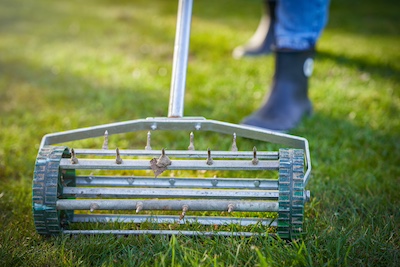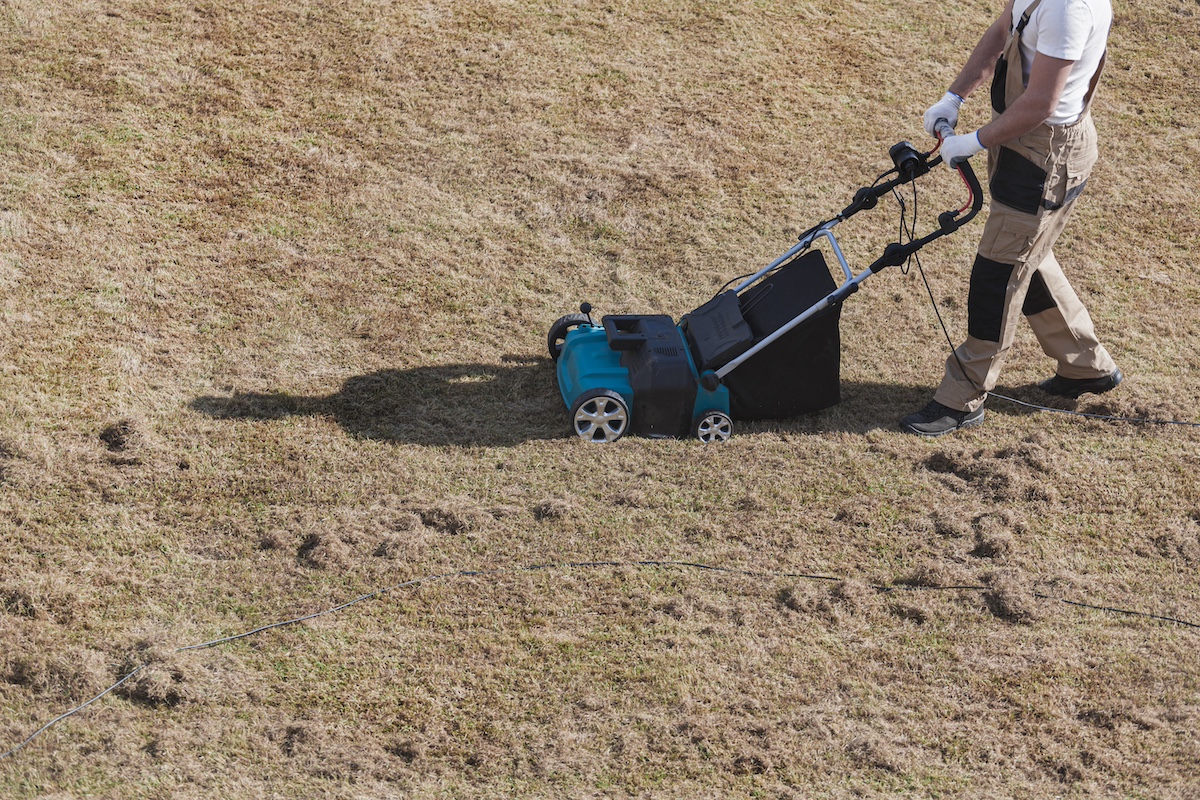In the realm of lawn care, lawn aeration stands as a crucial yet often overlooked step toward maintaining a vibrant, healthy lawn. This process, often confused with simple watering, brings a host of benefits to your grass, soil, and the overall appearance of your yard.
This introduction will help you understand the fundamentals of lawn aeration, explore the variety of aeration techniques available, and provide the knowledge necessary to perform lawn aeration effectively.
Discover how methods such as spike aeration, plug aeration, and liquid aeration can significantly improve the quality of your lawn and when to employ each technique for maximum benefit.
Understanding Lawn Aeration
The guidepost of any lawn enthusiast’s journey, lawn aeration, is a vital process that the layman often overlooks! A strange word? Yes, it might sound like it, but once understood, it becomes the secret recipe to a lush, supple lawn. This article aims to break down what lawn aeration is and why it’s so important for that patch of paradise right at your doorstep.
Let’s start with the basics. Lawn aeration involves making small holes in the soil surface to allow air, water, and nutrients to penetrate the grassroots. Imagine our lungs gasping for breath; well, the grass needs to breathe too!
Most lawns benefit from yearly aeration, and it should be undertaken typically in the growing season when the grass can heal and fill in the areas where the plugs were removed.
So, why all this fuss around jabbing holes into the fertile soil? Well, lawn aeration helps alleviate soil compaction that restrictive, compacted soil layers can cause. Compact soils have too many solid particles in a specific volume or space, challenging for essential plant life elements like air, water, and nutrients to penetrate.
Now, onto the big guns: the benefits of lawn aeration. Aeration bolsters your turf’s health and vigor by facilitating the easy exchange of much-needed oxygen between the soil and atmosphere. It also promotes robust root growth by allowing the roots to expand into the lawn aeration spaces, leading to a more vigorous lawn.
Moreover, it helps water to find its path downwards, laying the foundation for efficient use of water and irrigation.
Considering overseeding your lawn? Lawn aeration is an excellent precursor to overseeding! This process improves seed-to-soil contact, leading to robust seedling growth. What’s more, lawn aeration aids in reducing thatch buildup, a layer of mainly dead turfgrass tissue notorious for keeping water and nutrients from entering the soil.
Undeniably, lawn aeration might seem like a chore to the untrained eye. But to the enlightened, it’s a time-tested method that boasts an array of benefits, including strengthened turfgrass roots and improved water, nutrient, and oxygen movement in the soil. It contributes to a more resilient lawn and better prepares the turf for periods of stress like heat or low rainfall.
Think of lawn aeration as giving your lawn a much-deserved spa day! It is meant to rejuvenate and reenergize your lawn, paving the way for a healthier, greener, and more robust turf that can be the neighborhood envy! So, grab that spike aerator or plug aerator and allow your lawn the breath of fresh air it’s been yearning for! Happy gardening!

Types of Aeration Techniques
Transitioning from the theoretical aspects of lawn aeration, let’s delve into the practical realm. Various aeration techniques exist, each with its set of advantages and purposes. Knowing about them can empower you to make the best choice for your lawn. Here are the different types of lawn aeration techniques often used by enthusiasts and professionals alike:
- Spike Aeration: As the name implies, this technique involves using a spike aerator to create holes in the soil. The tool can either be a simple manual one, resembling a fork, or a machine with multiple spikes. Although this method provides less aeration compared to others due to merely pushing the soil aside, it’s advantageous for lawns with minor compaction problems.
- Core/Plug Aeration: If there’s severe soil compaction, the core, also known as plug aeration technique, comes into play. A core aerator removes plugs of soil and thatch from the lawn, leaving small gaps. These gaps allow room for the surrounding soil to expand, easing compaction. The extracted soil plugs generally break down naturally within a few weeks.
- Liquid Aeration: The world of lawn care is continually evolving, bringing innovative methods like liquid aeration to the forefront. This technique involves spraying a solution on the lawn that causes the soil particles to separate from each other, thereby increasing aeration. Although still debated among professionals, this method might be worth considering, especially for large lawns.
- Slicing Aeration: Using a slicing aerator, this method entails cutting through the grass and thatch and into your soil. Slicing aerators contain rotating blades that penetrate the soil, creating skinny, long slits. It is less disruptive than core aeration and can be more effective for lawns with sandy or loosely compacted soils.
- High-pressure Injection Aeration: This method requires equipment that inserts pressurized air or water into the soil, thereby fracturing it to improve aeration. Often used on golf greens and sports fields, it’s an excellent choice for compacted and drained soils.
Each aeration technique has its unique merits and demerits, and the choice ultimately depends on the nature of the lawn. It’s also important to consider the type of soil, extent of compaction, and resources at hand before selecting an aeration method. Happy aerating!
Performing Lawn Aeration
Next, let’s get to know the different methods of lawn aeration. Each technique has its pros and cons, and the choice often depends on your lawn situation, your location, and your own personal preference. Being aware of these methods will help you make an educated decision to best suit your green thumb objectives.
Spike aeration is a common place to start. This process involves a tool with solid tines, or spikes, that punctures the soil creating holes without removing any earth. This basic approach can be accomplished with shoes equipped with spikes, a spiked lawn roller, or a push-style spike aerator. Do remember though, that this method can contribute to lawn compaction over time if used excessively.
Core or plug aeration is the most effective method for most lawns. This technique utilizes a machine, known as a core aerator, which removes plugs or cores of turf and soil from the lawn. These small cores are typically 1/2″ to 3/4″ in diameter and 1” to 6” in length. The removed cores break down and feed the soil and grass with nutrients. This is the best technique for severely compacted or clay-heavy soils.
Liquid aeration is a less common but innovative form of aeration, suitable for smaller lawns or locations with strict regulations on lawn maintenance. This method uses a spray solution that breaks down thatch and loosens compacted soils, allowing water and nutrients to penetrate deeper into the root zone. Although not as effective as mechanical aeration methods, liquid lawn aeration can be a resourceful choice in the right conditions.
Slicing aeration cuts through the thatch and into the soil creating pathways for air, water, and nutrients. This form of aeration doesn’t produce a mess of soil and lawn plugs since no soil is removed. The slicing method uses rotating blades to slice into the turf, leaving the sliced turf in place, and is generally used on lightly compacted lawns.
High-pressure injection aeration, also known as air injection, is an advanced method where an air compressor forces air into the soil at high pressure. This method disrupts and loosens the soil without any significant surface disturbance or the presence of cores.
All in all, each aeration method caters to unique scenarios and lawn conditions. A combination of two methods could be used to maximize aeration effects, as each type offers different benefits. Nevertheless, proper application and timing are vital in lawn aeration. Avoid aerating during dry or stressed periods.
For cooler season grasses, early spring or fall are best. For warm-season grasses, late spring to early summer is prime for aeration. Once you’ve picked the most suitable method, then it’s all about getting down and dirty. And remember, this hobby isn’t just about the destination, but also the journey of learning and nurturing along the way!

Mastering Lawn Aeration
Armed with a newfound understanding of lawn aeration, including various techniques such as spike, plug, and liquid aeration, you can now embark on your journey of lawn maintenance with confidence. This knowledge will not only enable you to improve the health and appearance of your lawn, but also extend its longevity.
With the step-by-step process and guidelines provided, performing lawn aeration is no longer a mystery but a manageable and rewarding task. A well-aerated lawn is a symbol of pride and a testament to effective lawn care.
As you continue practicing and refining your aeration techniques, your lawn will undoubtedly mirror your efforts in its lush greenery and vitality.

